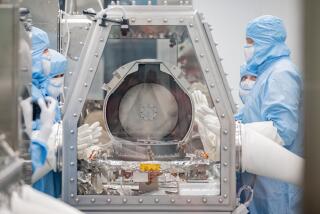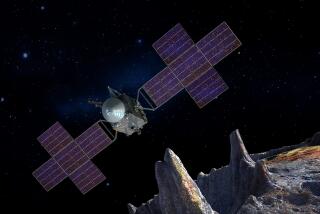NASA Cracks Open Comet to Bare Cosmic Mysteries
- Share via
An 820-pound comet-busting “bullet” released from NASA’s Deep Impact spacecraft successfully intercepted comet Tempel 1 late Sunday, creating a brief flash observed by telescopes in orbit and on Earth.
Traveling at a relative velocity of 23,000 mph, the copper “impactor” smashed into the surface of the comet at 10:52 p.m. PDT, vaporizing itself and sending a luminous plume of debris into space.
“Team, we have a confirmation,” mission control said five minutes later.
“That’s awesome,” said one observer in the control room as an image of the massive impact plume flashed on a screen at the Jet Propulsion Laboratory in La Canada Flintridge.
“We hit it just exactly where we wanted to. There’s no question about it,” said Don Yeomans, a co-investigator for the mission.
“We’ve got all the data we could possibly ask for,” Yeomans added. “The science team is ecstatic.”
Scientists will not know how big a crater the impactor produced on the comet’s nucleus until high-resolution images are processed, possibly today.
The late-night fireworks completed the first phase of a $333-million mission that researchers have described as hitting one bullet with another bullet while watching the process with a third bullet.
Researchers confirmed late Sunday that the impactor’s mother ship also survived its passage within 300 miles of the nucleus.
The craft is a crucial component to the mission, designed to photograph the collision and analyze debris with an infrared spectrometer.
The impactor took images of Tempel 1 until about three seconds before impact, relaying them back to Earth through the mother ship.
Early images confirmed researchers’ predictions about the comet: that it is a jet-black eggplant-shaped rock about 9 miles long and 3 miles wide, roughly the size of Washington, D.C.
The impactor -- made primarily of copper, an element that scientists know does not exist on the comet -- had separated from the mother ship 24 hours earlier.
After separation, the mother ship fired its thrusters for 14 minutes, reducing its speed by 220 mph to take it out of the comet’s path.
The impactor settled into the comet’s orbit, where it was overtaken and struck by Tempel 1.
Launched from Cape Canaveral Air Station in Florida on Jan. 12, Deep Impact has traveled about 200 million miles to intercept Tempel 1 just inside the orbit of Mars, about 83 million miles from Earth.
Its goal is to determine what comets are made of -- whether they are balls of compacted ice and rock or loosely agglomerated rubble.
The shape of the impact crater will tell researchers how firmly the comet is held together, and spectroscopic analysis of the debris will tell them what is on the inside, hidden from earthbound researchers.
.The crater could be the size of a small house or as large as the Rose Bowl, depending on how tightly the cometary materials are compacted.
In fact, mission scientists at JPL, where the mission is being controlled, have a betting pool on how big the crater would be.
Comets are relics of the materials from which the solar system was assembled 4.6 billion years ago, and astronomers believe that their interiors have remained intact ever since.
Researchers believe that comets were the source of much of the water and organic materials now present on Earth.
“We want to understand how the inside is different from what we see from the ground,” said Michael A’Hearn of the University of Maryland, who proposed the mission and is in charge of it. “That will then allow us to understand what came to Earth from comets.”
*
Times staff writer Brad Wible contributed to this article.






